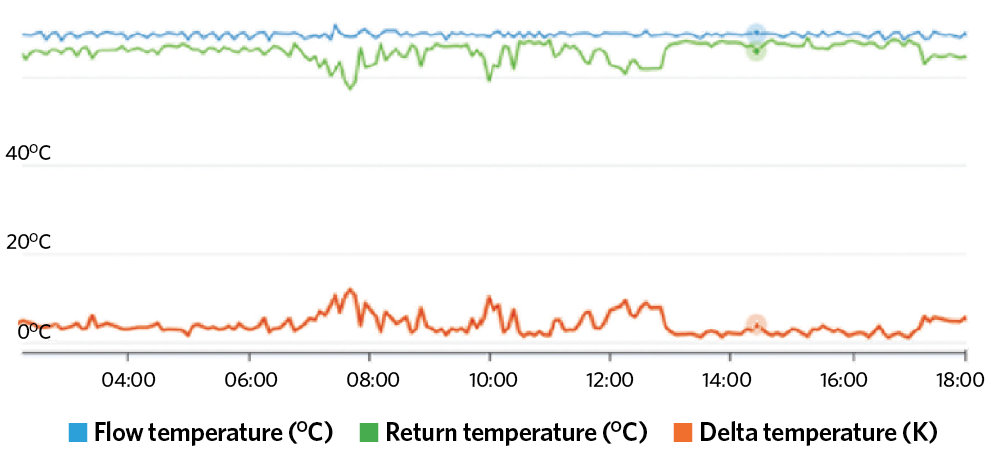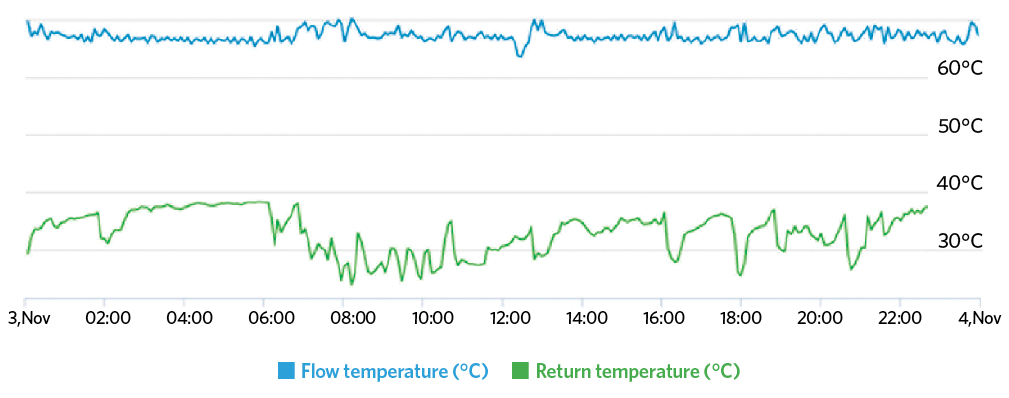
Acceptance testing took place at Telford Homes flats at Manhattan Place, London
In recent years, the reputation of heat networks has suffered from negative media coverage. Stories of residents reporting high bills and poor performance have obscured examples of well-run, value-for-money systems.
The anecdotal evidence was backed up by a review of 30 heat networks carried out by FairHeat in 2015, for a project funded by the Department for Business, Energy and Industrial Strategy. One of the key findings was that network losses were larger than expected, with return temperatures much higher than those set out at design stage.
We believe the performance of heat networks could be transformed by the introduction of acceptance testing, which can reveal whether they are performing to the standards promised by designers before being handed over to tenants. The process involves testing domestic systems to performance metrics set out in advance. Any shortfalls are identified before handover, and this helps ensure commissioning has been carried out correctly.
The majority of networks that go through our process are now performing at, or better than, estimates at the design stage, with return temperatures consistently below 40°C and regularly below 25°C. Testing is under way or completed on 20 developments, with more than 2,600 homes examined. Such has been its success that the process is now built into contracts with clients, and eight organisations – delivering more than 6,000 homes per year – specify acceptance testing.
Performance standards are being driven up by the process. Networks designed to achieve 70°C flow and 40°C returns have average return temperatures consistently below 40°C, with some sites’ average return temperatures as low as 32°C.
A heat loss per dwelling (W/dwelling) metric is used to evaluate the performance of heat networks. Principal engineer Tom Naughton, says: ‘At some sites where we have carried out acceptance testing in 100% of the flats, we are beginning to see consistent heat losses of below 70 W/dwelling. These are the first heat networks that have been through the full process, but – with improvements in design – we’re looking at another significant drop in heat losses.’
How acceptance testing works
Figure 1 shows typical network performance, with a small system delta T and very high return temperatures, which equate to high network losses, high £/kWh heat tariffs and overheating.
We found that most of the issues affecting network performance could have been resolved at the commissioning stage, often through relatively minor interventions. This was especially true at dwelling level. The following five issues have all been uncovered by using acceptance testing:
- Poorly commissioned heat interface units (HIUs) – valves set incorrectly, resulting in high primary return temperatures during all modes of operation
- Secondary circuits unbalanced – radiators and underfloor heating circuits not balanced correctly resulting in poor heat delivery to residents (for example, cold radiators) and high primary return temperatures
- Missing or poorly installed insulation – on primary pipework within the dwelling, leading to overheating
- Bath temperatures in excess of Building Regulations – thermostatic mixing valves (TMVs) not commissioned correctly, resulting in unsafe temperatures at the bath outlet
- Flushing bypasses left open – above the HIU, resulting in high primary return temperatures and an increase in energy centre pump electricity consumption.
All of these issues were resolved by feeding the information back to the site team and the contractor revisiting to correct them. Resolving issues before occupancy is important financially, because working in buildings after occupancy is expensive and disruptive. It also ensures tenants have a positive experience when moving into their new home.
To enable performance to be assessed, a clear set of performance criteria and a testing methodology for use in dwellings was developed. The testing criteria includes:
- Domestic hot water (DHW) – check: set point; outlet temperature; primary return temperature
- Standby – check: normal operation of primary valve; standby flow volumes; volume weighted average return temperature (VWART) meets minimum requirements when standby operating (from data)
- Space heating – check: secondary flow temperature (or return temperature) set point; VWART meets minimum requirements when space heating operating (from data).

Figure 1: Typical network performance, with a small system delta T and very high return temperatures
All the performance metrics can be assessed before occupation and can be made using the infrastructure in place – for example, heat meters or simple measurement devices, such as a hot-water temperature probe.
Acceptance testing has milestones that set out the roles and obligations of different parties. This is important from a contractual perspective and helps with the adoption of the process by contractors. The process enables systemic issues – such as incompatible communications between HIU and underfloor heating systems – to be identified early on in projects, saving contractors substantial rework.
Telford Homes is one of the developers to build acceptance testing into its contracts. It currently has six developments, accounting for around 1,200 properties, going through the process. Anthony Atkinson, estates and customer services director, says the developer can agree performance standards with the contractor in advance, test against those standards before handover, and then test again 12 months down the line. ‘This brings peace of mind to all involved and reduces any potential inconvenience to our residents,’ he adds.
Two years after handover, the Guinness Partnership’s Stead Street Block C, where acceptance testing was piloted, is operating at 70°C flow, 32°C return, with about 100W losses per dwelling. The scheme was designed as 70° flow and 40°C return. The process led directly to a reduction in losses of 28% and a saving to residents of £65 per year.

Figure 2: Data from an acceptance testing project – design 70°C flow/40°C return. Average return temperature <35°C
Changing attitudes
The work to date has produced a growing evidence base, and contractors are beginning to view acceptance testing as a valuable tool for reducing costs and improving outcomes. They can work hand in hand with project teams to pick up and resolve issues early in the process, saving post-occupancy and call-back work.
Atkinson agrees that the views of contractors have shifted. ‘Our contractors are well aware of the acceptance testing benefits,’ he says. ‘It brings fewer complaints and call backs for repairs, while enhancing brand reputation and working relationships.’
So, can it be a catalyst for transforming the dented reputation of heat networks? ‘We’ve shown that with a structured approach to commissioning – backed by a relatively low-tech testing procedure – heat networks can deliver on their potential,’ says Atkinson.
‘By carrying out the right measurements and checks early in the process, we can cut out some major challenges, so we can start to change the narrative – with positive headlines and happy residents.’
